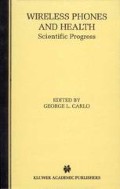Abstract
According to most scientific data, it may be anticipated that radiofrequency radiation is in itself not capable of breaking DNA or being genotoxic, especially when exposure is under so-called athermal conditions. Yet, occasionally, significant genetic changes (e.g., increased chromosome aberration frequencies) are found which may be ascribed to small differences in biological samples and/or in the exposure conditions. Experiments using well defined exposure conditions and materials should therefore be encouraged. Furthermore, up to now, little attention was paid to potential synergistic effects with chemical mutagens/carcinogens. Also, the choice of the investigated genetic endpoint is important. This is often not sufficiently taken into consideration when results are evaluated. Finally, experiments on biomonitoring should also consider the presence of possible hypersensitive subjects in the test population.
Access this chapter
Tax calculation will be finalised at checkout
Purchases are for personal use only
Preview
Unable to display preview. Download preview PDF.
References
Andersen, J. B., Johansen, C., Pedersen, Q. F., & Raskmark, P. (1995). On the possible health effects related to GSM and DECT transmissions: A tutorial study, Aalborg, Denmark: Aalborg University, Institute of Electronic Systems, Center for Perskommunikation.
Ciaravino, V., Meltz, M. L., & Erwin, D. N. (1987). Effects of radiofrequency radiation and simultaneous exposure with mitomycin C on the frequency of sister chromatic exchanges in Chinese hamster ovary cells. Environmental Mutagenesis, 9, 393–399.
Cohen, M. M., Kunska, A., Astemborski, J. A., & McCulloch, D. (1985). The effect of low-level 60Hz electromagnetic fields on human lymphoblastoid cells. II. Sister chromatic exchanges in peripheral blood lymphocytes and lymphoblastoid cell lines. Mutation Research, 172, 177–184.
Damiani, G., Laurenti, P., Marchetti, M., Capelli, G., Ossola, P., & Tofani, S. (1995). Potential genotoxic effect of elf-modulated radiofrequency magnetic fields on peripheral lymphocytes. In D. Simunic (Ed.), Electromagnetic hypersensitivity (pp. 19–29). Proceedings of COST 244 meeting (EEC, DGXIII/72/95-EN). Brussels, Belgium: European Economic Community.
Evans, H. J. (1977). Molecular mechanisms in the induction of chromosome aberrations. In D. Scott, B.A. Bridges, & F.H. Sobels (Eds.), Progress in genetic toxicology (pp. 57–74). Amsterdam: Elsevier.
Hinsenkamp, M. (1994). Stimulation electromagnetique, de l’osteogenese et de la consolidation des fractures (Duculot edition) [Electromagnetic stimulation of osteogenesis and fracture healing]. Gembloux, Belgium: Academic Royale de Belgique.
Lai, H., & Singh, N. P. (1995). Acute low-intensity microwave exposure increases DNA single-strand breaks in rat brain cells. Bioelectromagnetics, 16, 207–210.
Lai, H., & Singh, N. P. (1996). DNA single-and double-strand breaks in rat brain cells after acute exposure to low-level radiofrequency electromagnetic radiation. International Journal of Radiation Biology, 69, 513–521.
Lai, H., & Singh, N. P. (1997). Melatonin and a spin-trap compound block radiofrequency electromagnetic radiation-induced DNA strand breaks in rat brain cells. Bioelectromagnetics, 18, 446–454.
Léonard, A., Berteaud, A J., & Bruyere, A. (1983). An evaluation of the mutagenic, carcinogenic and teratogenic potential of microwaves. Mutation Research, 123, 31–45.
Maes, A., Collier, M., Slaets, D., & Verschaeve, L. (1996). 954 MHz microwaves enhance the mutagenic properties of mitomycin C. Environmental and Molecular Mutagenesis, 28, 26–30.
Maes, A., Verschaeve, L., Arroyo, A., De Wagter, C., & Vercruyssen, L. (1993). In vitro cytogenetic effects of 2450 MHz waves on human peripheral blood lymphocytes. Bioelectromagnetics, 14, 195–501.
Rosenthal, M., & Obe, G. (1989). Effects of 50-Hz electromagnetic fields on proliferation and on chromosomal alterations in human peripheral lymphocytes untreated or pretreated with chemical mutagens. Mutation Research, 210, 329–335.
Saunders, R. D., Kowalczuk, C. I., & Sienkiewics, Z. J. (1991). Biological effects of exposure to nonionizing electromagnetic fields and radiation. III. Radiofrequency and microwave radiation (NRPB-R240). Chilton, Didcot, Oxfordshire, UK: National Radiological Protection Board.
Simunic, D. (Ed.). (1995). Electromagnetic hypersensitivity. Proceedings of COST 244 meeting, (EEC, DGXIII/72/95-EN). Brussels, Belgium: European Economic Community.
Tarricone, L., Cito, C., & D’Inzeo, D. (1993). Ach receptor channel’s interaction with MW fields. Bioelectrochemistry & Bioenergetics, 30, 275–285.
Verschaeve, L., Slaets, D., Van Gorp, U., Maes, A., & Vankerkom, J. (1994). In vitro and in vivo genetic effects of microwaves from mobile telephone frequencies in human and rat peripheral blood lymphocytes. In D. Simunic (Ed.), Mobile communications and extremely low frequency fields & instrumentation and measurements in bioelectromagnetic research: Proceedings of COST 244 meetings (pp. 74–83), (EEC,DGXIII/J31/94-FR). Brussels, Belgium: Euopean Economic Community.
Editor information
Editors and Affiliations
Rights and permissions
Copyright information
© 2002 Kluwer Academic Publishers
About this chapter
Cite this chapter
Verschaeve, L. (2002). Some Considerations on the Genotoxicity of Radiofrequency Radiation. In: Carlo, G.L., Supley, M., Hersemann, S.E., Thibodeau, P. (eds) Wireless Phones and Health. Springer, Boston, MA. https://doi.org/10.1007/0-306-46899-9_7
Download citation
DOI: https://doi.org/10.1007/0-306-46899-9_7
Publisher Name: Springer, Boston, MA
Print ISBN: 978-0-7923-8347-5
Online ISBN: 978-0-306-46899-5
eBook Packages: Springer Book Archive

